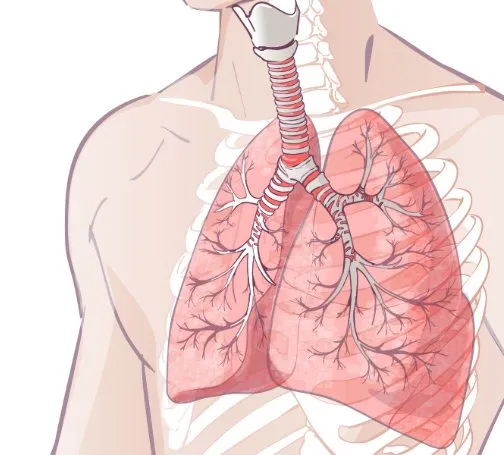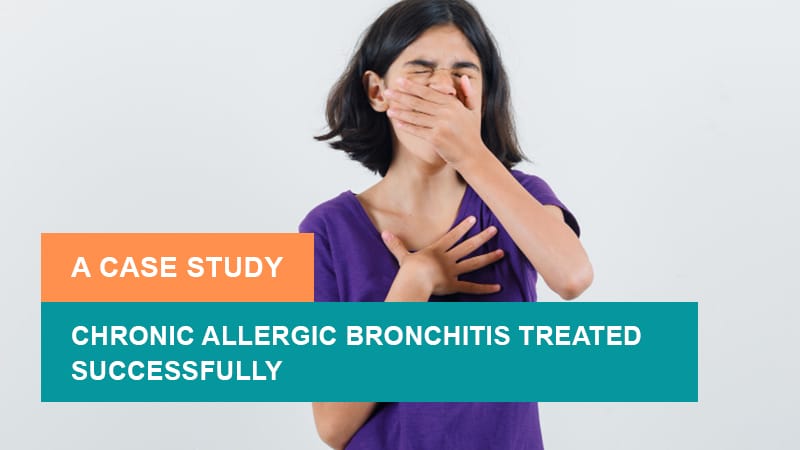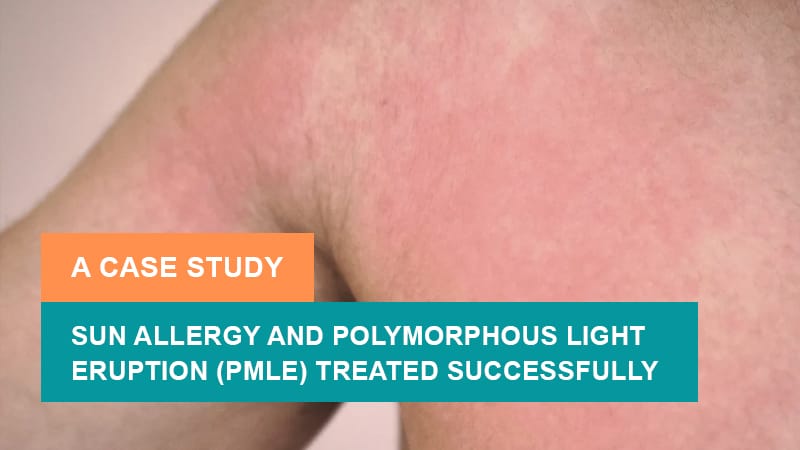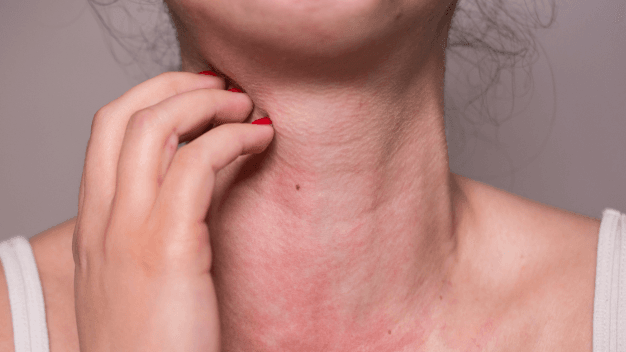On This Page
Hypersensitivity Pneumonitis (Tamaka Swasa)
प्रतिलोमंसिरागच्छन्नुदीर्यपवन: कफम् l
परिग्रह्यशिरोग्रीवमुर: पार्श्वेचपीडयन् l l (अ.हृ.नि.४/६) l l
Hypersensitivity pneumonitis (HP) is an interstitial lung disease. It can cause breathing difficulties and can result in irreversible injury to lung tissue. It is caused by the breathing of certain environmental allergens that lead to allergic reactions in the body. These allergens can be present at home, at the workplace, or in surroundings. Animal fur, bird feathers, and droppings, pollen, and molds are examples of common allergens. In Ayurveda, a similar condition is explained as Tamaka Shwasa.
Causes of Hypersensitivity Pneumonitis
Hypersensitivity Pneumonitis is more easily affected by people having some specific occupations. These occupations include:
- Those working with animals like farmers, veterinarians, bird or poultry handlers, etc.
- People are involved in the processing of grains, vegetables, etc.
- People employed in wood mills.
- People working in electronics, plastic manufacturing, and painting industries.
Hypersensitivity Pneumonitis is caused by inhalation of certain allergens into the lungs that result in inflammation of the lungs. HP is usually caused suddenly about 4-6 hours after inhalation of allergens. The causative allergens include:
- Bacteria
- Molds and fungi
- Some chemicals
- Certain proteins
Repeated exposure to the above allergens may keep the lungs inflamed. If exposed to low levels of allergens continuously for a longer period can also result in chronic HP.
In Ayurveda, the reasons for Tamaka Swasa include exposure to cold wind, humid climate, rain, and other Kapha aggravating factors.
Symptoms of Hypersensitivity Pneumonitis
The symptoms of acute HP may last between 12 hours and several days. It includes:
- The cough usually without sputum
- Tightness of chest
- Shortness of breath
- Chills
- Fever
- Fatigue
In chronic HP, rarely there occur irreversible and permanent damage to the lung tissue, known as pulmonary fibrosis. Due to reduced oxygen supply to body tissues following symptoms are seen in pulmonary fibrosis:
- Shortness of breath
- Dry cough
- Weight loss
- Fast and shallow breathing
- Rounding and widening of fingers
Symptoms of Tamaka Swasa as explained in Ayurveda include cough, fatigue, tastelessness, hoarseness of voice, runny nose, etc.
Ayurvedic Reference of Hypersensitivity Pneumonitis
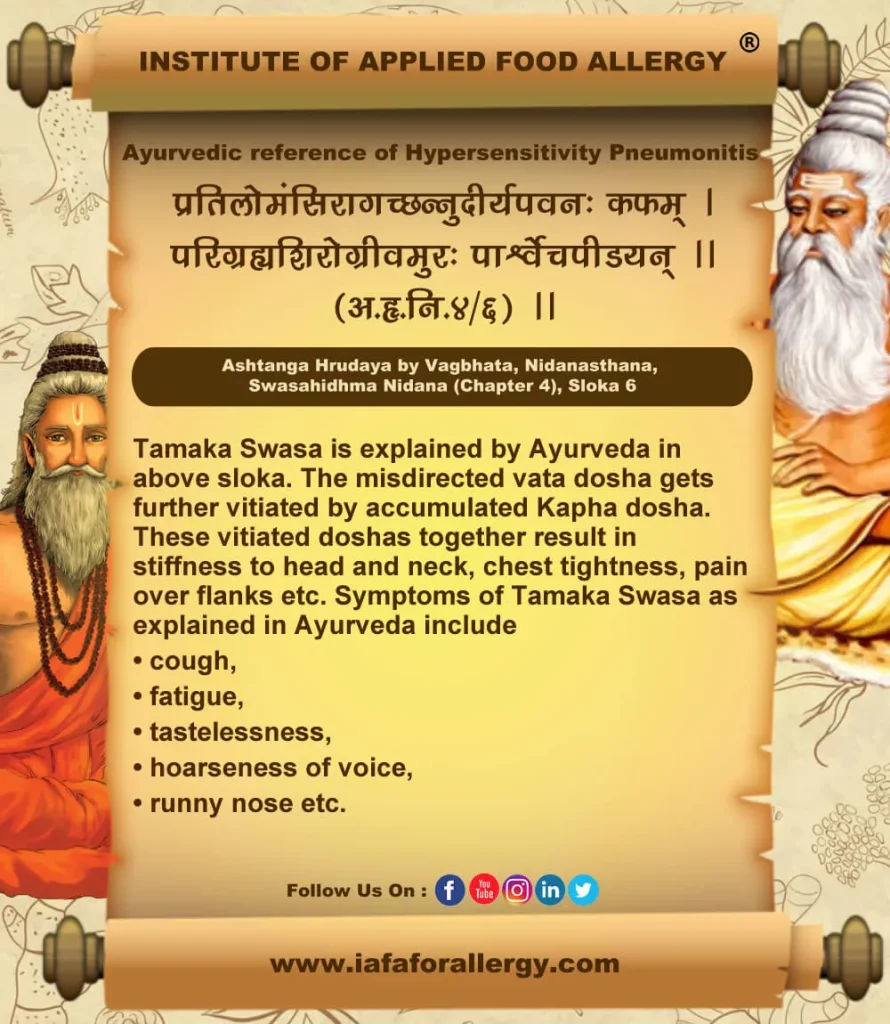

“Dr. Gupta’s IAFA is dedicated to the genuine Ayurvedic management of various allergic illnesses including Hypersensitivity Pneumonitis. Institute of Applied Food Allergy® is the most reliable institution for all your concerns about allergies”.
Reach IAFA and be free from your allergies!!!
– Dr. Sahil Gupta (B.A.M.S., M.H.A.)
Ayurvedic Allergy Specialist
CEO & Founder of IAFA®
At last, Easier Hypersensitivity Pneumonitis Management

Trusted by
More than 90,000 Patients

Convenient
at-Home Treatments

9.2 / 10
Customer Satisfaction Score
Ayurvedic Treatment of Hypersensitivity Pneumonitis
Vata and Kapha doshas are directly involved in the manifestation of Hypersensitivity pneumonitis. So Ayurveda emphasizes normalizing Vata dosha and Kapha dosha.
Ayurveda suggests internal medicines, purification therapy, and other ayurvedic treatment procedures to treat hypersensitivity pneumonitis (interstitial lung disease) permanently.
Internal Medicines for Hypersensitivity Pneumonitis
- Indukantham Kashayam
- Dasamoolakaduthrayam Kashayam
- Amruthotharam Kashayam
- Elakanadi Kashayam
- Dasamoola Rasayanam
- Kushmanda Rasayana
- Agastya Rasayanam
- Chyavanaprasa Lehya
- Swasanandam Gulika
- Dasamoolarishtam
- Kanakasava
Purification Therapy in Hypersensitivity Pneumonitis
Purification therapies are advised after analyzing the strength of the disease as well as the patient. It includes:
- Vamana (Vomiting)
- Virechana (Purgation)
- Vasti (Enema)
- Nasya (Administering Nasal Drop)
Treatment Procedures in Hypersensitivity Pneumonitis
- Dhoomapanam (Inhalation of Medicated Smoke)
- Swedana (Local Steaming)
Single Herb Used in the Management of Hypersensitivity Pneumonitis
- Haridra (Curcuma longa)
- Tulsi (Ocimum sanctum)
- Vasa (Adhatoda vasica)
- Amruta (Tinospora cordifolia)
- Karpooravalli (Coleus amboinicus)
- Pippali (Piper longum)
- Maricha (Piper nigrum)
- Kantakari (Solanum xanthocarpum)
Diet in Hypersensitivity Pneumonitis
Pathya (Do’s)
- Vegetarian diet
- Fresh & warm food
- Fruits and salads with a sour taste
- Hot & sour veg soup
- Hot gruel
- Green gram preparations
- Use of well-ventilated rooms especially during working & sleeping
- Drink warm water intermittently
- Steam inhalation with appropriate herbal medicines
- Light exercise preferably brisk walking
Apathya (Don’ts)
- Milk & milk products
- Non-vegetarian diet
- Deep-fried food
- Refrigerated food & drinks
- Smoking
- Travel and working in polluted areas
- Use of A/C rooms for working and sleeping
- Travel to high altitude places
- Suppression of natural urges
- Exposure to humid atmosphere
Yoga and Pranayama for Hypersensitivity Pneumonitis
The practice of Yoga is very effective in boosting the functionality of the body along with the mind. Following asanas (postures) can be practiced:
- Trikonasana
- Gomukhasana
- Paripurna Navasana
- Matsyasana
- Bhujangasana
- Urdhva Mukha Svanasana
- Phalakasana
Pranayama is also very effective in the management of Hypersensitivity pneumonitis. It enhances the performance of the respiratory system.

Frequently Asked Questions
Question: What is Hypersensitivity Pneumonitis?
Answer: Hypersensitivity Pneumonitis is the inflammation of lung tissues caused by inhalation of different allergens.
Question: What are the main allergens causing Hypersensitivity Pneumonitis?
Answer: The main allergens responsible for Hypersensitivity Pneumonitis include various bacteria, molds, and fungi, certain proteins and chemicals.
Question: Is Ayurvedic management effective in Hypersensitivity Pneumonitis?
Answer: Yes. Ayurvedic management of Hypersensitivity Pneumonitis includes overall therapy with internal medicines, external medicines, purification of body channels, and external therapies. This can ensure a complete and tremendous cure from Hypersensitivity Pneumonitis.
Question: What is Hypersensitivity Pneumonitis?
Answer: In Ayurveda, hypersensitivity pneumonitis is known as Tamak Shwasa which is a type of Shwasa Roga (respiratory disease) which affects Pranavaha Srotas. The description of Tamaka Shwasa, in Ayurvedic texts seems to be identical with the description of bronchial asthma in modern medicine.
Question: What is the cause of Hypersensitivity Pneumonitis?
Answer: The causative factors of Hypersensitivity Pneumonitis according to Ayurveda is as a result of exposure to specific Vata and Kapha vitiating factors.
Question: What is the treatment of Hypersensitivity Pneumonitis?
Answer: Ayurveda can provide promising results in Tamaka Shwasa through a set of various types of treatment modalities.
Question: What is the role of Pranayama in Tamaka Shwasa?
Answer: Pranayama causes non-functional or closed airways to work. It also promotes abdominal respiration thus providing relief to the main muscle of respiration i.e., the diaphragm. Various Pranayama that are helpful are: Kapalbhati, Anulom- Vilom etc.
References
- Ashtanga Hrudaya by Vagbhata, Nidanasthana, Swasahidhma Nidana (Chapter 4), Sloka 6.
- Chakrapani. Charak Samhita of Charaka with Ayurvedic Commentary Chikitsasthana 17/55-60. Delhi: Rashtriya Sanskrit Sansthan; 2006. p. 533, 535.
- Acharya Jadavji Trikamji. Sushruta Samhita with Nibandhasangraha commentary of Dalhanacharya, Uttaratantra, 51/39. Varanasi: Chaukhambha Orientalia; 2009. p. 764.
- Pandey R. Bhavaprakash Nighantu of Bhavmishra, Haritakyadi Varga, 252. 3rd ed. Varanasi: Chaukhambha Surbharati Prakashan; 2003. p. 34.
- Sahil Gupta, Ayurvedic Aspects of Allergies and Fungal Infections, Edition 2021, Hypersensitivity Pneumonitis Chapter No. 09, Page No. 55-60.
Dr. Gupta’s IAFA is dedicated to the genuine Ayurvedic management of various allergic illnesses including Hypersensitivity Pneumonitis. IAFA is the most reliable institution for all your concerns about allergies.
Reach IAFA and be free from your allergies!!!
Was this Page Helpful?
So IAFA Root-Cause Treatment of Your Hypersensitivity Pneumonitis is Just 3 Steps Away!

01. Connect With Us
Share your history of illness or Book your appointment

02. Consult With Us
Dr. Gupta a certified Ayurvedic Allergist Consultant

03. Root Cause Treatment
Get an accurate diagnosis, medicines, diet & lifestyle change
Hypersensitivity Pneumonitis – Case Studies
Real Case Studies of Successfully Treated Patients from All Around the World by IAFA Ayurveda®

9 Year Old Female Patient Recovered from Chronic Allergic Bronchitis – A Case Study
This case study presents a 9-year-old female patient who has successfully recovered…

12-Year-Old Child Recovered from Sun Allergy and Polymorphous Light Eruption (PMLE) – A Case Study
This is a case study of a 12-year-old child who has successfully…

40-Year-Old Female Patient Recovered from Dyshidrotic Eczema and Onychomycosis – A Case Study
This case study highlights the successful recovery of a 40-year-old female patient…

40-Year-Old Female Patient Recovered from Urticaria and Angioedema – A Case Study
This case study focuses on a 40-year-old female patient who has successfully…
Read More Articles

Mast Cell Diseases
Discover Ayurvedic treatment for Mast Cell Diseases, including types, causes, symptoms, and…

High Immunoglobulin-E (IgE) Levels
Discover Ayurvedic treatment for high Immunoglobulin-E (IgE) levels. Learn about the causes,…

Histamine Intolerance
Discover Ayurvedic treatment for histamine intolerance, its causes, symptoms, and natural treatment.…

